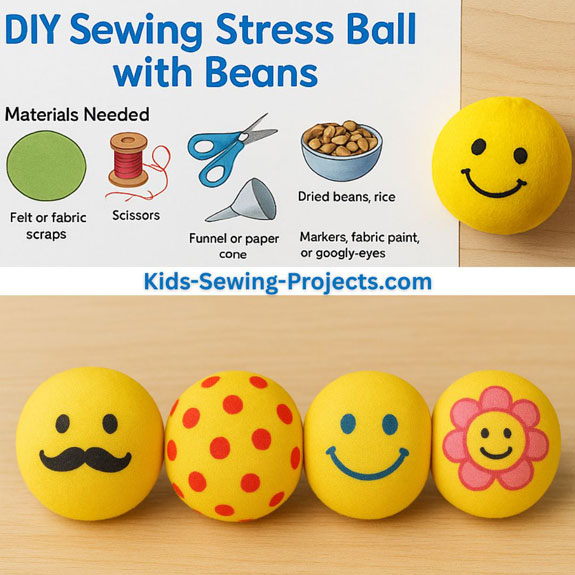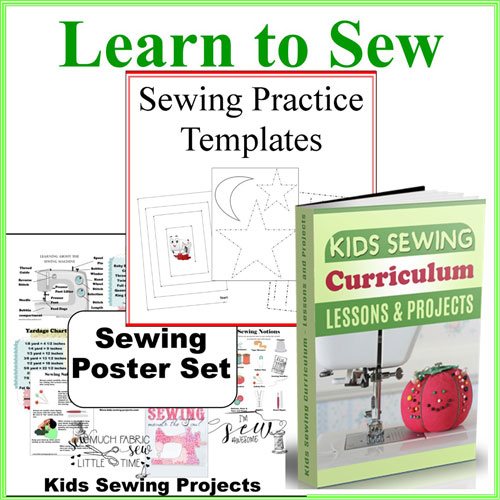A stress ball filled with beans
by Nathalie
(Ontario, Canada)
Many years ago, at the beginning of my teaching career, I taught a special education class. We made stress balls and filled them with beans. One child filled it with marbles (a little on the noisier size, but he loved it and used it often). I used this project, and others, to teach reading, writing, mathematics, science and social studies
It was fantastic!
(The children in my class ranged from 7 to 12 years old)
DIY Sewing Stress Balls (Beans or Marbles)

Hands-on project for ages 7–12 that builds fine-motor skills and connects to reading, writing, math, science, and social studies.
Materials
- Felt or woven fabric scraps (about 6” × 6” / 15 × 15 cm)
- Needle & thread (embroidery floss works great)
- Scissors
- Filling: dried beans, rice, or marbles (noisier but fun!)
- Small funnel (or paper cone)
- Fabric markers/paint, googly eyes (optional)
- No-sew option: fabric glue
- Safety: thimbles, adult supervision
Step-by-Step Instructions
1) Cut the Fabric
Trace a 5–6 inch (12–15 cm) circle using a bowl or lid. Cut along the line.2) Stitch Around
Thread the needle and knot the end. Sew a running stitch about ½ inch (1.25 cm) from the edge, all the way around the circle.3) Gather into a Pouch
Gently pull the thread to gather the edge and form a little pouch. Leave a 1–2 inch opening.4) Fill
Use a funnel to add beans, rice, or marbles until the ball feels firm yet squeezable.5) Close & Secure
Pull the thread tight to close the opening. Add a few cross-stitches for strength, tie a double knot, and trim the thread.6) Decorate (Optional)
Add a face, patterns, or feelings emojis with fabric markers; glue eyes if desired.No-Sew Variation: Cut two felt circles. Glue around the edge, leaving a small gap. Fill, then glue the gap closed. Let dry fully before squeezing.
Teacher Notes & Differentiation (Ages 7–12)
For Younger Learners (7–9)
- Pre-trace circles; start stitches for them.
- Use blunt needles, chunky floss, and felt (won’t fray).
- Limit to a small handful of filling.
Extend for Older Learners (10–12)
- Teach backstitch or whipstitch for stronger seams.
- Compare two fillings (beans vs. marbles) and record data.
- Design a character set: calm, silly, focused.
Cross-Curricular Learning Extensions
Reading & Writing
- Write the procedure in their own words (first/then/finally).
- Create a short story about their stress ball character (name, personality, when it helps).
- Vocabulary mini-book: stitch, seam, gather, estimate, mass.
Mathematics
- Estimate and then measure filling mass using a kitchen scale.
- Record data (table/tally) for scoops/grams; make bar graphs.
- Measure circle diameter; discuss how circle size affects capacity.
Science
- Compare materials (beans, rice, marbles, sand): texture, weight, sound.
- Discuss solids that flow (granular materials) and why the ball is flexible.
- Fair test: keep same circle size & stitch length; change only the filling.
Social Studies
- Map where beans and rice are grown globally; discuss trade routes.
- Explore traditional hand-sewing and toys from different cultures.
- Community discussion: self-regulation tools and inclusion.
Art & SEL
- Design “emotion balls” (happy/sad/calm) to talk about feelings.
- Surface design with simple embroidery (X’s, running lines, dots).
Safety & Cleanup
- Always supervise needle use; store needles in a pin cushion when not sewing.
- Keep marbles away from children who may mouth small objects.
- Sweep/vacuum any spilled fillings to prevent slips.
Sewing Materials Available


